Pioneer DV-535K User Manual
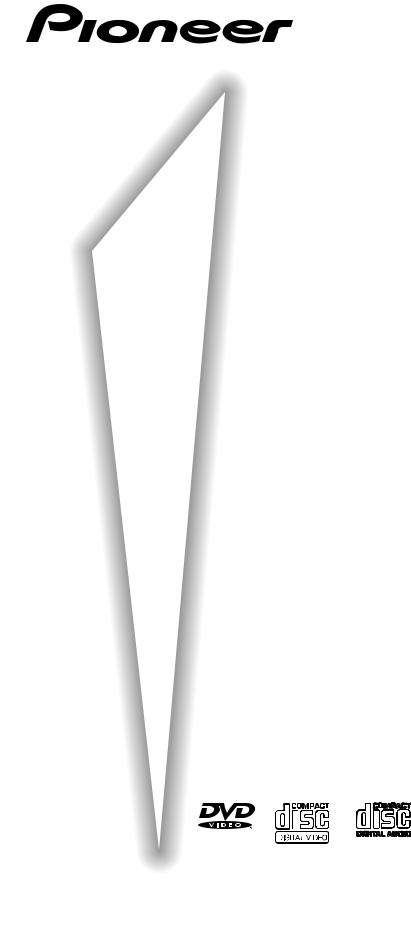
DVD PLAYER
DV-535 DV-535K
Operating Instructions
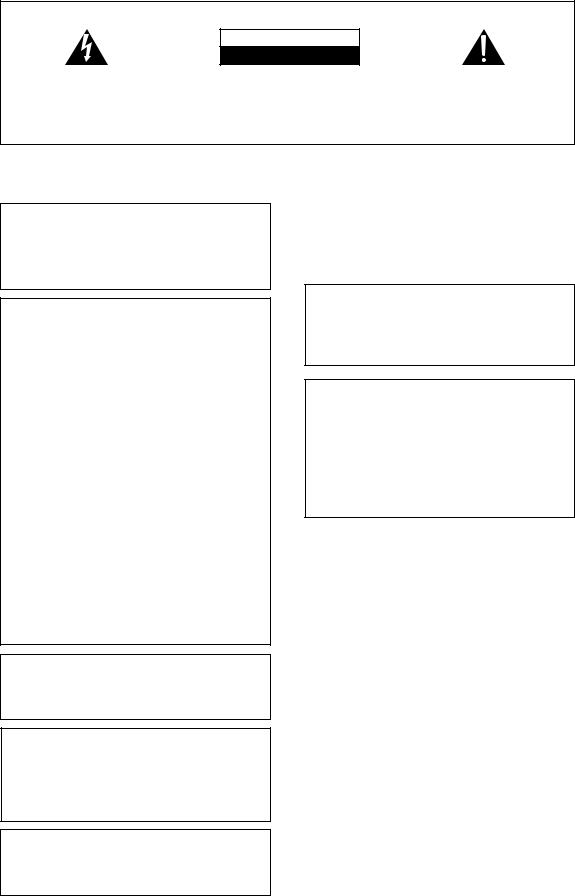
IMPORTANT
CAUTION
RISK OF ELECTRIC SHOCK
DO NOT OPEN
The lightning flash with arrowhead symbol, within an equilateral triangle, is intended to alert the user to the presence of uninsulated "dangerous voltage" within the product's enclosure that may be of sufficient magnitude to constitute a risk of electric shock to persons.
CAUTION:
TO PREVENT THE RISK OF ELECTRIC SHOCK, DONOTREMOVECOVER(ORBACK).NOUSERSERVICEABLE PARTS INSIDE. REFER SERVICING TO QUALIFIED SERVICE PERSONNEL.
The exclamation point within an equilateral triangle is intended to alert the user to the presence of important operating and maintenance (servicing) instructions in the literature accompanying the appliance.
WARNING: TO PREVENT FIRE OR SHOCK HAZARD, DO NOT EXPOSE THIS APPLIANCE TO RAIN OR MOISTURE.
CAUTION: This product satisfies FCC regulations when shielded cables and connectors are used to connect the unit to other equipment. To prevent electromagnetic interference with electric appliances such as radios and televisions, use shielded cables and connectors for connections.
NOTE:
This equipment has been tested and found to comply with the limits for a Class B digital device, pursuant to Part 15 of the FCC Rules. These limits are designed to provide reasonable protection against harmful interference in a residential installation. This equipment generates, uses, and can radiate radio frequency energy and, if not installed and used in accordance with the instructions, may cause harmful interference to radio communications. However, there is no guarantee that interference will not occur in a particular installation. If this equipment does cause harmful interference to radio or television reception, which can be determined by turning the equipment off and on, the user is encouraged to try to correct the interference by one or more of the following measures:
–Reorient or relocate the receiving antenna.
–Increase the separation between the equipment and receiver.
–Connect the equipment into an outlet on a circuit different from that to which the receiver is connected.
–Consult the dealer or an experienced radio/TV technician for help.
Information to User
Alteration or modifications carried out without appropriate authorization may invalidate the user's right to operate the equipment.
CAUTION
•Use of controls or adjustments or performance of procedures other than those specified herein may result in hazardous radiation exposure.
•The use of optical instruments with this product will increase eye hazard.
THE STANDBY/ON BUTTON IS SECONDARY CONNECTED AND THEREFORE DOES NOT SEPARATE THE UNIT FROM MAINS POWER IN STANDBY POSITION.
CONGRATULATIONS ON YOUR PURCHASE OF THIS FINE PIONEER PRODUCT.
Pioneer is on the leading edge of DVD research for consumer products and this unit incorporates the latest technological developments.
We are sure you will be fully satisfied with the DVD player.
Thank you for your support.
Please read through these operating instructions so you will know how to operate your model properly. After you have finished reading the instructions, put them away in a safe place for future reference.
• This player is not suitable for commercial use.
This product incorporates copyright protection technology that is protected by method claims of certain U.S. patents and other intellectual property rights owned by Macrovision Corporation and other rights owners. Use of this copyright protection technology must be authorized by Macrovision Corporation, and is intended for home and other limited viewing uses only unless otherwise authorized by Macrovision Corporation. Reverse engineering or disassembly is prohibited.
2

Features of This Player
Compatible with DVD, Video CD and CD formats
DVD, Video CD and CD discs that display the logos shown below can be played back on PIONEER DVD players. For more information on discs compatible with this player, refer to the table below.
Types of playable |
Diameter/ |
|
|
discs and their marks |
Playable sides |
|
Playback time |
DVD VIDEO |
DVD VIDEO |
|
Digital audio |
|
|
|
Digital video |
|
|
|
(MPEG 2) |
|
12 cm (5in.)/ |
1 layer |
133 min. |
|
single-sided |
2 layer |
242 min. |
|
12 cm (5in.)/ |
1 layer |
266 min. |
|
double-sided |
2 layer |
484 min. |
|
DVD VIDEO |
|
Digital audio |
|
|
|
Digital video |
|
|
|
(MPEG 2) |
|
8 cm (3 in.)/ |
1 layer |
41 min. |
|
single-sided |
2 layer |
75 min. |
|
8 cm (3 in.)/ |
1 layer |
82 min. |
|
double-sided |
2 layer |
150 min. |
VIDEO CD |
VIDEO CD |
|
Digital audio |
|
|
|
Digital video |
|
12 cm (5 in.)/ |
|
(MPEG 1) |
|
single-sided |
|
Max. 74 |
|
|
|
minutes |
|
VIDEO CD single |
Digital audio |
|
|
8 cm (3 in.)/ |
|
Digital video |
|
|
(MPEG 1) |
|
|
single-sided |
|
Max. 20 |
|
|
|
minutes |
CD |
CD |
|
Digital audio |
|
12 cm (5 in.)/ |
|
Max. 74 |
|
single-sided |
|
minutes |
* |
CD single |
|
Digital audio |
|
|
||
|
8 cm (3 in.)/ |
|
Max. 20 |
* |
single-sided |
|
minutes |
|
|
|
|
The disc format logos shown above are found on disc labels or on disc jackets.
•To prevent malfunction, do not use an 8 cm (3 in.) adaptor (for CDs).
•Discs other than the ones indicated above cannot be played on this unit.
•DVDs that have incompatible region numbers, DVDAudio, DVD-ROM, and CD-ROM cannot be played on this unit. The region number of the player can be found on the rear panel.
*Playing recordable CDs
•Note that this unit cannot record onto recordable discs.
•This unit can play music-use CD-R and CD-RW discs. However, depending on the condition of the CD Recorder and the disc, you may find that not all discs will play successfully. (For example, if the disc is scratched or dirty, or if the player’s pickup lens is dirty.)
3
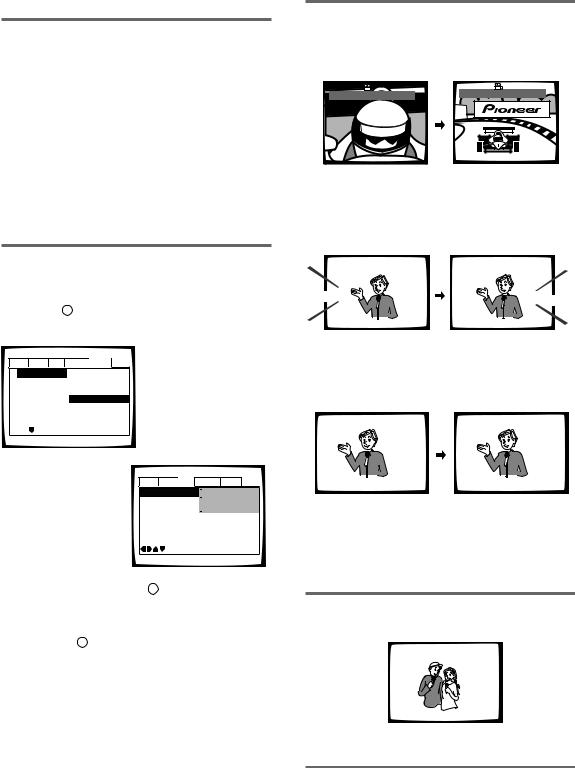
Compatible with a wide range of DVD digital audio output formats
1

DVDs are recorded in one of four types of digital audio formats (as of October 1998). The digital audio output jacks of this player output Dolby Digital*, DTS**, MPEG, and linear PCM digital bitstreams.
This player has a function that converts Dolby Digital and MPEG audio formats into the linear PCM format. This allows playback of DVDs recorded in Dolby Digital and MPEG without the need for a decoder.
Easy setup and adjustment using on-screen menus
Press SETUP on the remote control to open the Setup screen and you’ll find setting up and adjusting the system easy to do with on-screen menus conveniently organized and arranged. Additionally, on-screen information ( i ) appears to clarify the functions and explain the options available. Below are just a few examples.
Audio1 Audio2 Video Language
 General
General
Setup Navigator
Setup Navigator |
Start |
|||
Move |
|
Auto Start Off |
||
|
Select |
|
Exit |
|
ENTER |
SETUP |
|||
Select the type of TV screen you are using and the preferred screen format you’d like to use when watching DVDs in the Video menu (page 28).
Answer a few questions and have all the necessary audio, video, and on-screen language adjustments set automatically by the player using the Setup Navigator (page 17).
Audio1 Audio2 Video Language General
Video Language General
TV Screen 
 4:3(Letter Box) Picture Quality -
4:3(Letter Box) Picture Quality -  4:3(Pan&Scan)
4:3(Pan&Scan)

 16:9(Wide)
16:9(Wide)
 Select your display preference
Select your display preference
Move |
SETUP |
Exit |
The on-screen information ( i ) only appears if you choose [English] as the [OSD Language] (page 18, 31).
While using the Setup Navigator, no on-screen information ( i ) is displayed.
*Manufactured under license from Dolby Laboratories. “Dolby” and the double-D symbol are trademarks of Dolby Laboratories. Confidential unpublished works.
© 1992-1997 Dolby Laboratories. All rights reserved.
**“DTS” and “DTS Digital Surround” are trademarks of Digital Theater Systems, Inc.
Wide range of DVD viewing options
Multi-Angle (page 30)
You can view scenes from different camera angles when watching movies or other media with multiple angle playback available.
ANGLE : 2/4 |
ANGLE : 3/4 |
|
Multiple Languages (page 32)
You can select the language on when watching movies or other media that have multiple language and/or audio soundtracks recorded on them.
|
|
Dolby Digital |
|
|
|
Dolby Digital |
Audio |
: 1 English |
5.1CH |
|
Audio |
: 2 Spanish |
5.1CH |
HELLO |
HOLA |
Multi-Language Subtitles (page 33)
You can select a subtitle language or turn subtitles off when watching movies or other media with subtitles available.
Subtitle :1 English |
|
Subtitle :2 Spanish |
HELLO! |
HOLA! |
 This mark indicates this may not be possible with certain discs.
This mark indicates this may not be possible with certain discs.
Karaoke microphone input and mixing controls (DV-535K only)
With this player, it is possible to sing along with karaoke discs or your favorite CD. You can also control the vocal mix using the volume and digital echo effect controls.
Energy-saving design
This unit is designed to use less than 1 W of energy when this player is in standby mode.
4

Table of contents |
|
Before Using ........................................ |
7 |
Checking Accessories ..................................... |
7 |
Preparing the Remote Control ......................... |
7 |
Names and Functions ......................... |
8 |
Front Panel ...................................................... |
8 |
Display Window ............................................... |
9 |
Rear Panel ..................................................... |
10 |
Remote Control ............................................. |
11 |
Making Connections ......................... |
13 |
Connecting Your DVD Player ......................... |
13 |
Audio Connections ........................................ |
14 |
Video Connections ......................................... |
15 |
System Control Connections ......................... |
15 |
TV SYSTEM switch ........................................ |
16 |
Setting Up the Player ....................... |
17 |
Using the Setup Navigator............................. |
17 |
Getting Started Using Your DVD |
|
Player.................................................. |
20 |
Playing DVDs, Video CDs and CDs ................ |
20 |
Chapter (Track) Skip Forward/Skip Back ........ |
22 |
Forward and Reverse Scanning ..................... |
22 |
Resuming playback from where |
|
you stopped ............................................. |
23 |
Stopping Playback and Switching |
|
Power Off ................................................ |
23 |
Adjusting Audio and Video Settings |
|
............................................................ |
24 |
Using the Setup Screen Menus .................... |
24 |
Changing to the Setup Screen “Expert” Menu |
|
Mode........................................................ |
25 |
Setting the Digital Audio Output To Be |
|
Compatible with Your AV Component ...... |
26 |
Adjusting the Dynamic Range of the Audio |
|
Soundtrack ............................................... |
27 |
Setting the TV Screen Size ............................ |
28 |
Selecting Picture Quality Appropriate for |
|
Program Content...................................... |
29 |
Viewing from a Desired Camera Angle |
|
(Multi-Angle)............................................. |
30 |
Setting the Language Options......... |
31 |
Setting the on-screen display |
|
(OSD) language ........................................ |
31 |
Setting Language and Subtitle Preferences in |
|
the Setup Screen Menus ......................... |
31 |
Changing the Audio Language |
|
(Multi-Language Function) ....................... |
32 |
Selecting a Subtitle Language |
|
(Multi-Language Subtitles) ....................... |
33 |
Advanced Functions ......................... |
36 |
Setting the Parental Lock Level ..................... |
36 |
Changing the Background Color |
|
of the Screen ........................................... |
37 |
Singing Your Favarite Songs Along with |
|
Karaoke Discs .......................................... |
38 |
Still Frame/Slow Play/ |
|
Frame Advance Playback ......................... |
39 |
Searching for a Title, Chapter, Track, |
|
or Location on a Disc ............................... |
40 |
Repeat Play .................................................... |
41 |
Random Play .................................................. |
42 |
Playback in a Desired Order |
|
(Program Play) .......................................... |
43 |
Continuing Playback from a |
|
Specified Location (Last Memory) ........... |
46 |
Memorizing Settings for Often |
|
Viewed DVDs (Condition Memory) .......... |
47 |
Viewing Disc Information .............................. |
48 |
Resetting the Player to System Settings ....... |
49 |
Additional Information ..................... |
50 |
Disc Care ....................................................... |
50 |
For Proper and Long Use of This Unit ........... |
51 |
Language Code List ....................................... |
52 |
Troubleshooting ............................................. |
53 |
Terms ............................................................. |
54 |
Specifications ................................................ |
56 |
5
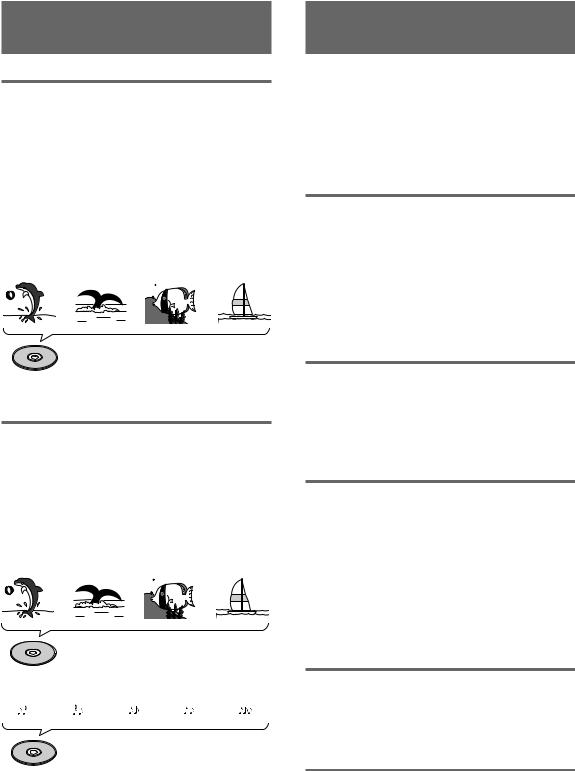
Differences in Disc
Composition
DVD
DVDs are divided into units referred to as titles, and titles are divided into chapters. A DVD which contains a movie may have only one title with many or no chapter divisions. Karaoke DVDs may have many titles, assigning a title to each song on the disc. Menu screens do not belong to any title.
DVD player functions generally apply to titles on a disc or chapters within a selected title. The player functions available may also vary from title to title, depending on the disc. When discs have a unique title division, it should be noted that search and program functions may be affected.
|
|
Title 1 |
|
|
|
|
|
Title 2 |
|
||||
|
|
|
|
|
|
|
|||||||
Chapter 1 |
|
Chapter 2 |
|
Chapter 1 |
|
|
Chapter 2 |
||||||
|
|
|
|
|
|
|
|
|
|
|
|
|
|
|
|
|
|
|
|
|
|
|
|
|
|
|
|
DVD
Video CD/CD
Video CDs and CDs are divided into units referred to as tracks (Video CD tracks may also be referred to as scenes). One song generally corresponds to one track. Some tracks are further divided into units referred to as indexes. Video CDs with PBC (Playback Control) also contain menus recorded on the disc which enable easy access to the contents of the disc.
When played back on a DVD player, both Video CDs and CDs are considered to be a single title, regardless of the number of tracks.
Track 1 |
Track 2 |
Track 3 |
Track 4 |
|||
|
|
|
|
|
|
|
Video CD
Track 1 |
|
Track 2 |
Track 3 |
Track 4 |
Track 5 |
|||||
|
|
|
|
|
|
|
|
|
|
|
|
|
|
|
|
|
|
|
|
|
|
CD
How to Proceed in This
Manual
DVD is an incredible format that presents the highest quality digital audio and video available today. The amount of information that can be recorded onto a DVD disc is remarkable, allowing it to offer numerous functions and features available with no other format. Because using the DVD player and DVDs may be confusing at first, following the order below should help you get through the important stages of getting set up so you can start using your player as soon as possible.
Get familiar with the player.
Refer to the section “Before Using” on page 7 to confirm that all the accessories were included with the player. If you are new to DVD, it might be beneficial for you to go through the “Names and Functions” section starting on page 8 to get familiar with the parts and buttons on the main unit and remote control as they will be referred to throughout this manual.
There is also a list of terms that can be found on page 54 if you are having trouble understanding some of the terminology associated with DVD.
Make the necessary connections.
No entertainment system seems to be set up exactly the same way. The “Making Connections” section starting on page 13 shows how video and audio connections may be made to suit your home entertainment system.
Set up the necessary player menus.
Before you can begin to enjoy the benefits of the DVD format, it is first necessary to set up the player to output the video and audio information that corresponds to your system. The section “Setting Up the Player” starting on page 17 explains how to use the Setup Navigator, a function that automatically sets up the player corresponding to the answers given in a multiple-choice on-screen procedure. The Setup screen menus, described in the section starting on page 24, are also used in a number of other functions. Learning the procedure for operating these menus will make using this player much easier and more enjoyable.
Play a disc.
When all the connections and setups have been made, you are ready to play a DVD, Video CD, or CD with the player. The section “Getting Started Using Your DVD
Player” starting on page 20 outlines the basic player operations.
Enjoy the many features available.
Once you are comfortable using the basic player functions, you are ready to take advantage of the various options DVD and this player have to offer. The section
“Advanced Functions” starting on page 36 describes how to use the features available on many DVDs.
6
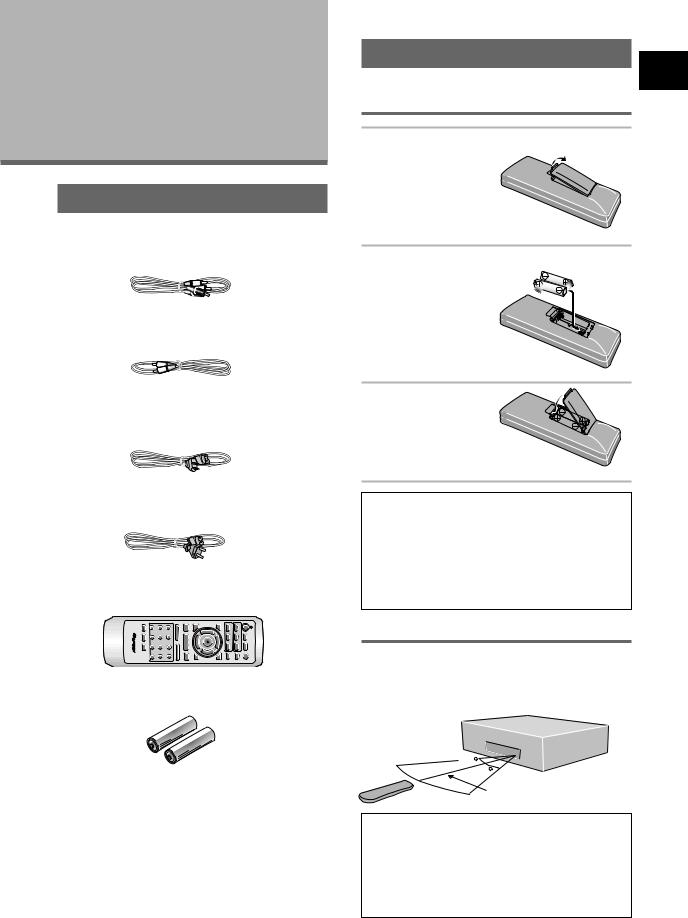
Before Using
Checking Accessories
Please confirm that the following were received with the player.
Audio cord
Video cord
Power cord
<Flat blade 2-pin AC plug model>
<Round blade 2-pin AC plug model>
(Either of the two power cords above is supplied.)
Remote control unit
RANDOM |
8 7 |
|
4 |
1 |
STEP/SLOWE e |
|
7STOP |
¶ |
PREV |
NT |
¶ |
DISPLAY |
MENUSETUP |
TITLESUB AUDIO |
|
PROGRAMMODESEARCHÎ |
09 |
|
6+105 |
CLEAR32 |
REVFWD1¡ |
|
PAUSEPLAY83 |
¶5 |
|
5 |
5¶ |
|
|
|
OPEN/ LASTCONDITIONCLOSE MEMORYMEMORY |
¶ |
¶ |
NEXT¢ |
E |
RETURN |
REPEAT B-A |
REPEAT |
|||||||||
|
|
|
|
|
|
|
|
|
|
E |
|
|
MENU TOP |
|
|
|
|
|
|
|
|
|
|
|
|
R |
|
|
ANGLE |
|
|
|
|
|
|
|
|
|
|
|
|
|
|
|
|
||
|
|
|
|
|
|
|
|
|
|
5 |
|
|
|
|
|
AA (R6P) dry cell batteries
Preparing the Remote Control
Inserting batteries into the remote
control |
BEFORE |
|
1 |
While pushing the tab on the battery |
USING |
|
||
|
compartment cover |
|
|
toward the center |
|
|
of the remote, pull |
|
|
out in the direction |
|
|
indicated by the |
|
|
arrow. |
|
2 |
Insert batteries. |
|
|
Make sure to match |
|
|
the plus (+) and minus |
|
|
(–) polarity guides on |
|
|
the batteries with the |
|
|
marks inside the |
|
|
battery compartment. |
|
3 |
Close the cover. |
|
Notes
•Do not mix old and new batteries.
•When replacing batteries, use all new batteries.
•When not using the remote control for a long period of time (over 1 month), remove the batteries to avoid possible damage from battery corrosion. If battery leakage occurs, wipe the battery liquid from the battery component, then insert new batteries.
Remote control operation
When operating the remote control, point it at the remote sensor (Î) located on the player’s front panel. The remote control can be used up to 7 m (23 feet) from the player and within a 30° angle on each side of the sensor.
30 

30
Operating instructions (this manual) |
7m (23ft.) |
Notes
• Exposing the remote sensor to direct sunlight or strong light may cause faulty operation.
• If the CONTROL IN jack on the player’s rear panel is connected to the CONTROL OUT jack of another component, point the remote control at the other component to operate the player. Operation will not be possible when pointed at this player (page 15).
7
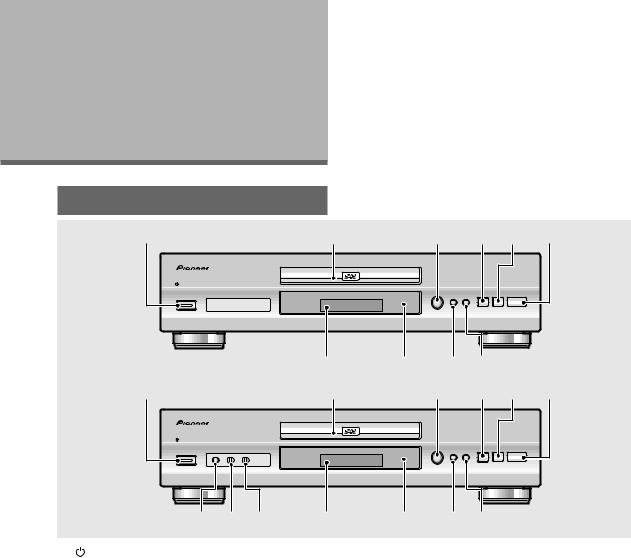
Names and
Functions
Front Panel
1 |
2 |
3 |
4 5 |
6 |
DV-535
|
DVD PLAYER |
|
|
|
|
STANDBY/ON |
0 |
41 ¡¢ |
7 |
8 |
3 |
|
|
Î |
|
|
|
|
0 |
9 |
8 7 |
|
|
1 |
2 |
3 |
4 |
5 |
6 |
DV-535K
|
DVD PLAYER |
|
|
|
|
|
|
|
STANDBY/ON |
MIC |
VOLUME |
ECHO |
0 |
41 ¡¢ |
7 |
8 |
3 |
MIN–MAX MIN–MAX |
|
Î |
|
~ = - |
0 |
9 |
8 7 |
1 STANDBY/ON button |
8 4 1 (reverse) button |
Press to switch the player on or to put in standby (pages 20, 23).
2Disc tray
When loading a disc, place discs in the disc tray with the label side facing up (pages 20, 23).
30 (open/close) button
Press to open and close the disc tray (pages 20, 23).
47 (stop) button
Press to stop playback. Pressing once enables playback to resume from a point shortly before the location where it stopped. Pressing twice causes the disc to return to the beginning of the disc if playback starts again (page 23).
5 8 (pause) button
Press during playback to pause. Press again to resume playback (page 39).
63 (play) button
Press to start or resume playback (pages 20, 23).
7 ¡ ¢ (forward) button
Press to go back to previous chapters/tracks. Press and hold to perform reverse playback scanning (pages 22).
9Remote sensor
Point the remote control toward the remote sensor to operate the player (page 7).
0Display window
Displays system information (page 9).
-ECHO control (DV-535K only)
Turn to adjust the amount of digital echo effect to add to the vocals when using the karaoke function (page 38).
=VOLUME control (DV-535K only)
Turn to adjust the volume of the vocals when using the karaoke function (page 38).
~MIC input jack (DV-535K only)
Use to connect a microphone (not supplied) to the player to use the karaoke function. The karaoke function is active when a microphone is connected (page 38).
Press to advance to chapters/tracks. Press and hold to perform fast-forward scanning (page 22).
8
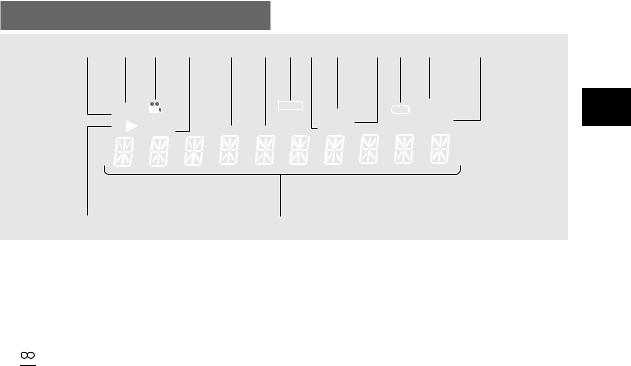
Display Window
1 2 3 4 5 6 7 8 9 0 - = |
|
~ |
|||||||
|
|
|
|
|
|
|
|
|
|
|
|
|
|
|
|
|
|||
|
|
|
|
|
|
|
|||
DVD |
|
GUI |
|
DOLBY |
|
|
|||
VCD |
|
CONDITION |
|
DIGITAL |
|
|
|||
|
|
|
|
|
|||||
|
|
|
|
|
TOTAL |
|
LAST |
|
|
|
|
|
TITLE |
TRK CHP |
REMAIN |
|
MEMO |
|
|
|
|
|
|
|
|
|
|
|
|
@ |
! |
1 VCD indicator |
9 CONDITION indicator |
VCD lights when a Video CD is loaded. CD lights when an audio CD is loaded.
2DVD indicator
Lights when a DVD is loaded.
3 
 indicator
indicator
Indicates Multi-Angle playback is in progress (page 30).
4TITLE indicator
Indicates a title number is being displayed.
5TRK indicator
Indicates a track number is being displayed.
6CHP indicator
Indicates a chapter number is being displayed.
7GUI indicator
Indicates an on-screen menu operation is being performed (pages 17, 24).
8REMAIN indicator
Indicates that the remaining playback time of a title or chapter/track is being displayed.
Indicates that Condition Memory settings are memorized for the currently loaded DVD (page 47).
0TOTAL indicator
Indicates that the disc in the player is stopped and DISPLAY has been pressed (page 49).
- indicator
indicator
Indicates that the Repeat function is on and that the current title, chapter, or track is being repeated (page 41).
=DOLBY DIGITAL indicator
Indicates Dolby Digital audio playback.
~LAST MEMO indicator
Indicates the Last Memory location is recorded in memory for the currently loaded DVD or Video CD (page 46).
!Counter display
Displays the playback mode, type of disc, title and chapter/track numbers, playback time, etc.
@83 indicator
3 light when any disc is playing. When a disc is paused, 8 lights.
FUNCTIONS AND NAMES
9

Rear Panel
1 |
2 3 4 5 |
6 |
DV-535 |
|
|
|
|
|
|
COMPONENT VIDEO OUT |
DIGITAL OUT |
AC IN |
||
|
|
||||
|
Y |
PB |
PR |
|
DIGITAL |
|
|
|
|
|
OUT |
|
|
|
|
|
OPT |
TV SYSTEM |
|
|
VIDEO |
CONTROL |
|
PAL |
|
|
OUT |
IN |
|
|
|
SELECT |
|||
NTSC |
AUTO |
|
|
|
|
|
R |
L |
VIDEO |
S-VIDEO |
|
|
AUDIO OUT |
|
|||
|
OUT |
OUT |
|
||
0 987 |
|
|
|
1 |
2 |
3 4 5 |
6 |
DV-535K
AC IN
|
|
|
COMPONENT VIDEO OUT |
DIGITAL OUT |
|
||
|
|
|
Y |
PB |
PR |
|
DIGITAL |
|
|
|
|
|
|
|
OUT |
|
|
|
|
|
|
|
OPT |
|
|
TV SYSTEM |
|
|
VIDEO |
CONTROL |
|
|
|
PAL |
|
|
OUT |
IN |
|
ATTENUATOR |
|
|
SELECT |
||||
NTSC |
AUTO |
|
|
|
|
||
ON |
OFF |
|
R |
L |
|
|
|
|
|
|
VIDEO |
S-VIDEO |
|
||
|
|
|
AUDIO OUT |
OUT |
OUT |
|
|
(*The TV SYSTEM switch is not present |
- 0* 987 |
on the DV-535K on the Taiwan model.) |
1COMPONENT VIDEO OUT jacks
If your TV or monitor has component video inputs, you can produce a higher quality picture on your TV or monitor by connecting to the component video outputs on this unit. When using these jacks, be sure to set VIDEO OUT SELECT to the right position (page 15).
2DIGITAL OUT jack (coaxial)
Use to output the digital audio signal recorded on discs. You can output the digital signal via either coaxial output jack to an AV amplifier or receiver (page 14).
3VIDEO OUT SELECT switch
Use to set which output is used to output the video signals. Select either video/S-video or component video signal output depending on the connections you make (page 15).
4DIGITAL OUT jack (optical (OPT.))
Use to output the digital audio signal recorded on discs. You can output the digital signal via either optical output jack to an AV amplifier or receiver (page 14).
6AC IN power cord connection terminal
Use to connect the power cord to the wall outlet (page 13).
7S-VIDEO OUT jack
If your TV or monitor has an S-video input, clear picture reproduction is possible by connecting the player to your TV or monitor via the S-Video jack. When using this output, be sure to set VIDEO OUT SELECT to the left position (page 15).
8VIDEO OUT jack
Connect to the video input on a TV or monitor or AV amplifier or receiver with video input capability. When using this output, be sure to set VIDEO OUT SELECT to the left position (pages 13, 15).
9AUDIO OUT jacks
Use to output two-channel audio (analog) to the audio stereo inputs on a TV or stereo amplifier. If you are connecting to a receiver that has both digital and analog input jacks for DVD player connection, it may be beneficial to make both connections (pages 13, 14).
5CONTROL IN jack
Use to connect this player to another component bearing the Pioneer Î mark. This lets you control this unit as though it were a component in a system. Player operations are then performed by pointing the remote control at the component that the player is connect to (page 15).
0TV SYSTEM switch* (except for DV-535K Taiwan model)
Use to change the TV signal mode to either PAL or NTSC according to the type of TV and disc to be used. When the switch is in the AUTO position, the player outputs the format on the disc as is (page 16).
-ATTENUATOR switch (DV-535K only)
Usually set to the OFF position. When enjoying karaoke, switch to the ON position if the sound is distorted.
10
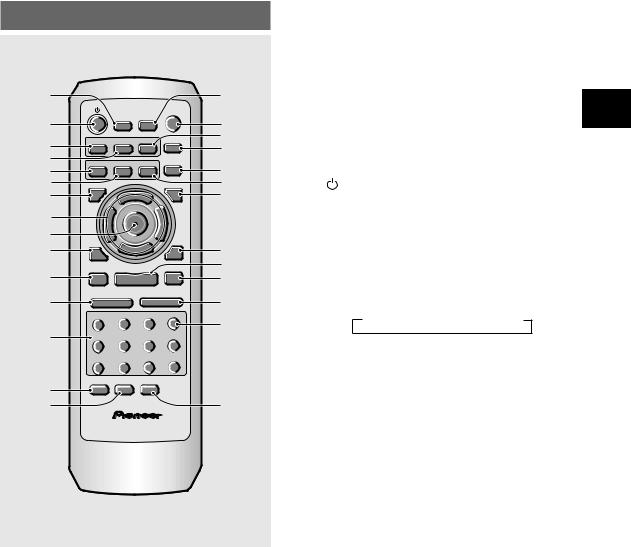
Remote Control
(Buttons indicated with * are used for menu operation.)
1 LAST MEMORY button
|
|
|
|
|
|
|
|
You can resume DVD or Video CD playback from the |
|
|
|
|
|
|
|
|
|
point you last watched even if the disc is removed |
|
|
|
|
|
|
|
|
|
from the player. Press LAST MEMORY during |
|
1 |
|
|
|
|
|
# |
|
playback to set a Last Memory point. When you |
|
|
|
|
|
|
|
want to resume playback of that disc, press LAST |
|
||
|
|
|
|
|
OPEN/ |
|
|
|
|
|
|
LAST |
CONDITION |
CLOSE |
|
|
MEMORY in the stop mode and playback starts |
|
|
2 |
|
MEMORY |
|
MEMORY |
|
$ |
|
|
|
|
|
|
|
|
|
from the memorized point. Last Memory locations |
NAMES |
||
|
|
|
|
|
|
% |
|
||
3 |
AUDIO |
SUB TITLE |
|
ANGLE |
REPEAT |
|
can be stored for up to 5 DVDs and 1 Video CD (page |
||
|
^ |
|
|||||||
|
|
|
|
|
|
46). |
|||
4 |
|
|
|
|
REPEAT |
|
|
||
SETUP |
MENU |
TOP MENU |
A-B |
|
|
|
|||
5 |
& |
|
|
||||||
|
|
|
|
|
|
|
|||
|
|
|
|
|
2 |
|
AND |
||
6 |
DISPLAY |
|
|
|
RETURN |
* |
(standby/on) button |
||
|
|
|
|
||||||
7 |
¶ |
|
5 |
|
¶ |
( |
|
Press to switch the player on or to put in standby |
|
|
|
|
FUNCTIONS |
||||||
|
|
|
T |
|
|
|
|
||
|
|
|
|
|
|
|
(pages 20, 23). |
||
|
|
N E |
|
|
|
||||
8 |
|
E |
|
R |
|
|
|
||
|
|
|
|
|
|
|
|||
|
|
|
|
|
|
|
|
||
9 |
PREV |
|
|
|
NEXT |
|
3 AUDIO button |
||
0 |
¶ 5 |
|
|
|
¢ |
) |
|||
|
5 |
|
5 ¶ |
|
Press repeatedly to select one of the audio |
||||
|
STOP 7 |
PLAY 3 |
PAUSE 8 |
_ |
|
|
|||
|
|
languages programmed on a DVD (page 32). |
|
||||||
- |
+ |
|
|
||||||
|
|
¶ |
|
|
For Video CD and CD, each press changes the audio |
|
|||
|
eSTEP/SLOWE 1REV |
FWD ¡ |
|
|
|
||||
= |
¡ |
|
output as follows. |
|
|||||
|
|
|
|
|
|
|
|||
|
|
|
|
|
|
|
|
||
|
1 |
2 |
|
3 |
CLEAR |
™ |
|
= Stereo =1/L (Left) =2/R (Right) |
|
|
|
|
|
|
|
|
|
||
~ |
4 |
5 |
|
6 |
+10 |
|
|
|
|
|
|
¶ |
|
|
|
|
4 SUBTITLE button |
|
|
|
7 |
8 |
|
9 |
0 |
|
|
||
|
|
|
|
|
|
|
|
Press repeatedly to select one of the subtitle |
|
! |
RANDOM |
PROGRAM SEARCH MODE |
|
|
languages programmed on a DVD or to turn the |
|
|||
|
|
|
|
Î |
|
|
|
||
|
|
|
|
|
|
subtitles off (page 33). |
|
||
@ |
|
|
|
|
|
£ |
|
|
|
|
|
|
|
|
|
|
|
||
|
|
|
|
|
|
|
5 SETUP button* |
|
|
|
|
|
|
|
|
|
|
Press when the player is in either play or stop mode |
|
|
|
|
|
|
|
|
|
to open and close the Setup screen (pages 17, 24). |
|
|
|
|
|
|
|
|
6 MENU button* |
|
|
Use to display or close the DVD menu screen (page 21).
7DISPLAY button
Press during playback to display statistical disc information. Press repeatedly to display different information (page 48).
8Cursor buttons (2/3/5/ )*
Use to move through the options on menu screens and to change settings.
9ENTER button*
Use to implement settings selected with the cursor buttons or to set items highlighted in a menu.
0PREV 4 (previous) button
During playback, press PREV 4 to go back to a previous chapter/track (pages 21, 22).
-STOP 7 button
Press to stop playback. Pressing once enables playback to resume from a point shortly before the location where it was stopped. Pressing twice causes the disc to return to the beginning of the disc when playback starts again (page 23).
11
=STEP/SLOW e/E buttons
Press STEP/SLOW E during playback to view slow playback. In pause mode, press STEP/SLOW E to advance DVDs and Video CDs frame by frame and STEP/SLOW e to back up a few frames at a time (page 39).
~Number buttons (1-9, 0, +10)*
Use to perform direct title and chapter/track searches, and to input numerical values.
!RANDOM button
Press to play chapters/tracks in random order (page 42).
@PROGRAM button
You can program titles, chapters, or tracks to play back in a desired order. Programs can be a maximum of 24 steps. Additionally, DVD programs for up to 24 discs can be stored in the player’s memory for future use (pages 43-45).
#CONDITION MEMORY button
You can store in memory the settings for up to 15 DVDs. Press CONDITION MEMORY during DVD playback to memorize the settings (page 47).
$OPEN/CLOSE button
Press to open or close the disc tray (pages 20, 23).
%ANGLE button
Some DVDs are recorded with various camera angle playback options. Press ANGLE repeatedly to display different camera angles (page 30).
^REPEAT button
Press once to repeat playback of current chapter/ track. Press twice to repeat playback of current title (page 41).
&REPEAT A-B button
Press at the beginning and end of the section you want to repeat or to mark a location you want to return to (page 41).
*TOP MENU button*
Press to call up the top menu programmed on the DVD. Depending on the DVD, the top menu may be identical to the DVD menu (page 21).
(RETURN button*
Use to go one menu back (current settings are maintained). Use RETURN when you do not want to change the option setting in a menu.
)NEXT ¢ button
During playback, press NEXT ¢ to advance to the next chapter/track (pages 21, 22).
_PLAY 3 button
Press to start or resume playback (pages 20, 23).
+PAUSE 8 button
Press to pause playback of a disc. Press again to resume playback (page 39).
¡1 REV/FWD ¡ (fast reverse/forward) buttons
During playback of DVD and Video CD, press FWD ¡ to perform fast forward scanning. Press REV 1 to perform fast reverse scanning of DVD
and Video CD. When a CD is loaded, audio scanning is performed (page 22).
™CLEAR button
Works in conjunction with a number of player functions. Use to cancel repeat and random playback, and to edit programs.
£SEARCH MODE button
Press to perform a title, chapter/track or elapsed time search (page 40).
12

Making
Connections
Connecting Your DVD Player
Unlike any other audiovisual media format, DVD offers a wide array of audio and video output options which allows playback to be enjoyed in any number of system configurations from a standard TV with stereo audio input to a home theater system with a TV or monitor and full surround sound capabilities.
Connection Guide
The illustration on this page shows the basic setup using the audio and video cords included with this player. Use this illustration as a guide to setting up your home system.
An explanation of each type of audio and video connection available can be found on pages 13 to 15. To determine the best audio and video connection setup for your system, refer to the manuals supplied with the components you are making connections to.
In addition to making physical connections to your TV or monitor, it is also necessary to assign the TV screen size. You can use the [Setup Navigator] in the Setup screen General menu to set whether you are using a wide screen or standard size TV or monitor (page 18). Additionally, you can use the [TV Screen] setting in the Setup screen Video menu (page 28).
Notes
•When making connections to this unit or when changing
connections, check that the unit is off by pressing
 STANDBY/ON and unplug the power cord from the power outlet.
STANDBY/ON and unplug the power cord from the power outlet.
•The video output on this player uses copy protect circuitry to prevent the video playback on DVDs from being copied. If you connect the player to a TV via a VCR, or record and play back the contents of a disc with a VCR, the playback picture may not be normal.
CONNECTIONS MAKING / FUNCTIONS AND NAMES
AC IN
COMPONENT VIDEO OUT |
DIGITAL OUT |
|
|
|
Y |
PB |
PR |
|
DIGITAL |
|
|
|
|
|
|
|
OUT |
|
|
|
|
|
|
|
OPT |
|
|
TV SYSTEM |
|
|
VIDEO |
CONTROL |
|
|
|
PAL |
|
|
OUT |
IN |
|
ATTENUATOR |
|
|
SELECT |
||||
NTSC |
AUTO |
|
|
|
|
||
ON |
OFF |
|
R |
L |
|
|
|
|
|
|
VIDEO |
S-VIDEO |
|
||
|
|
|
AUDIO OUT |
|
|||
|
|
|
OUT |
OUT |
|
||
Audio cord |
Video cord |
(Included) |
(Included) |
Finally, connect to a power outlet.
L R
AUDIO IN
Make audio connections from the AUDIO OUT jacks on the player to the AUDIO IN jacks on the TV or monitor using the stereo audio cord included with the player. Be sure to match the color of the plugs with the color of the jacks (red and white).
TV or monitor
VIDEO IN S-VIDEO IN
Make video connections from the VIDEO OUT jacks on the player to the VIDEO IN jack on the TV or monitor using the video cord included with the player. Set the VIDEO OUT SELECT to the left position.
13
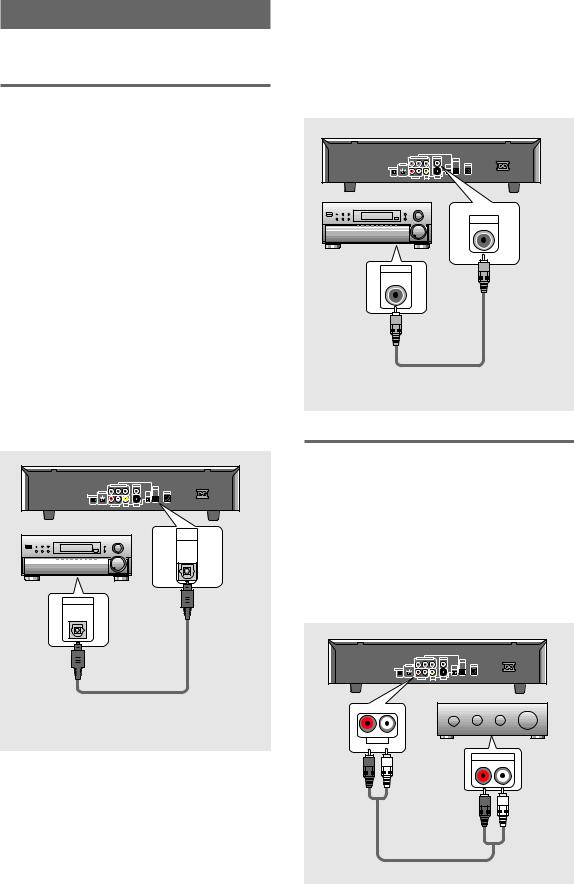
Audio Connections
This player features two digital (optical and coaxial) and also analog audio output formats.
Digital Audio Connections:
You can enjoy the digital audio recorded on discs from both optical digital and coaxial digital output jacks.
When making digital audio connections, do not make connections from both the coaxial and optical digital outputs to the same component.
When a DVD recorded in Dolby Digital, DTS, or MPEG is loaded, noise will be output if you have made connections via the digital audio jacks to a receiver or amplifier that cannot decode a Dolby Digital, DTS, or MPEG digital bitstream. In this case, be sure to set up the Setup Navigator audio settings to best reflect the type of system you are using (page 19). Additionally, the digital audio settings can be adjusted manually in the Setup screen Audio 1 menu (pages 26-27).
DIGITAL OUT (Optical)
The digital signal is transmitted as light pulses through a fiber-optic cable.
•Use to connect to an AV amplifier or receiver with built-in Dolby Digital, DTS, or MPEG decoder.
•Use a fiber-optic cable (not supplied) to connect the DIGITAL OUT OPT (digital optical output) on the player to the digital optical input on an AV amplifier or receiver.
AC IN |
DIGITAL
OUT
OPT
DIGITAL IN
AV amplifier or receiver with built-in Dolby Digital, DTS, or MPEG decoder
DIGITAL OUT (Coaxial)
The digital signal is transmitted electronically through a coaxial cable.
•Use to connect to an AV amplifier or receiver with built-in Dolby Digital, DTS, or MPEG decoder.
•Use a coaxial cable (not supplied) to connect the DIGITAL OUT (coaxial digital output) on the player to the coaxial digital input on an AV amplifier or receiver.
AC IN |
DIGITAL OUT
DIGITALL ININ
AV amplifier or receiver with built-in Dolby Digital, DTS, or MPEG decoder
Analog Audio Connection:
AUDIO OUT
•When using a microphone, connect like this.
•Make analog audio connections to a stereo amplifier or receiver.
•Analog audio connections can also be made to a TV or monitor with stereo input jacks.
•Use the supplied audio cord to connect the AUDIO OUT on the player to the audio input on the stereo amplifier or receiver.
•When making analog audio connections, be sure to match the color of the plugs with the color of the jacks (red and white).
AC IN |
R L
AUDIO OUT
AUDIO IN
R L
Stereo amplifier or receiver
14
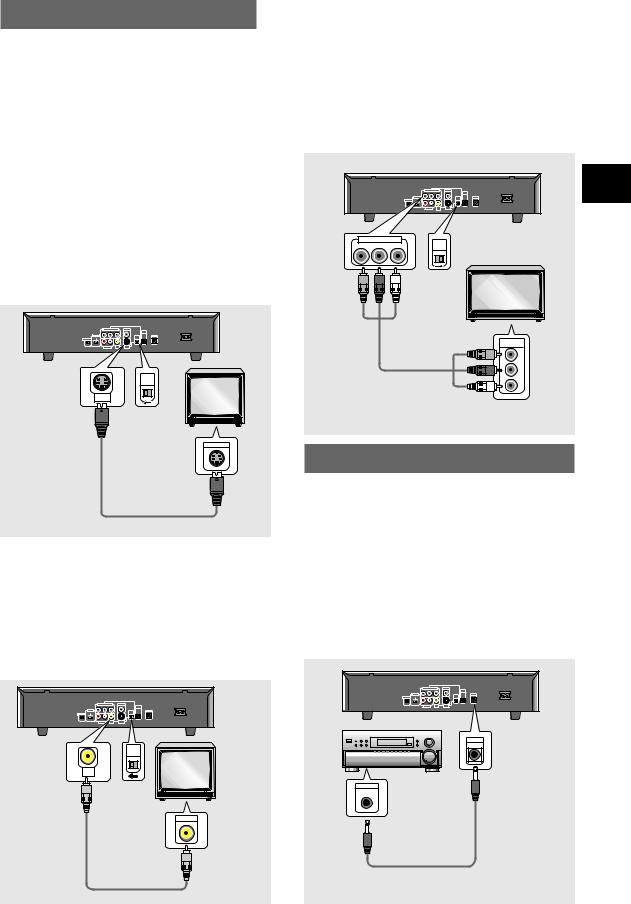
Video Connections
This player features S-video, composite, and component video output possibilities.
Check the manual supplied with your TV or monitor to determine the best possible connection for your system.
In addition to making physical connections to your TV or monitor, it is also necessary to assign the TV screen size. You can use the [Setup Navigator] in the Setup screen General to set whether you are using a wide screen or standard size TV or monitor (page 18). Additionally, you can use the [TV Screen] setting in the Setup screen Video menu (page 28).
S-VIDEO OUT
•Make S-video connections to a TV or monitor with S-video input to produce a high quality video image.
•Use an S-video cable (not supplied) to connect the S-VIDEO OUT jack on the player to S-video input on the TV or monitor.
•When making S-video connections, make sure to set the VIDEO OUT SELECT switch on the rear panel of the player to the left to assign S-video output.
AC IN |
VIDEO
OUT
SELECT
S-VIDEO
OUT
S-VIDEO IN
TV or monitor
VIDEO OUT
•Make composite video connections to a standard TV or monitor with a video input jack.
•Use the supplied video cable to connect one of the VIDEO OUT jack on the player to the video input on the TV or monitor.
•Be sure to match the color of the plug with the color of the jack (yellow).
•When making video connections, make sure to set the VIDEO OUT SELECT switch on the rear panel of the player to the left to assign composite video output.
AC IN |
VIDEO
OUT
SELECT
VIDEO
OUT
VIDEO IN
TV or monitor
COMPONENT VIDEO OUT
•Make component video connections to a TV or monitor with component inputs to produce a higher quality video image.
•Use a component video cable or 3 video cords (not supplied) to connect the COMPONENT VIDEO OUT jacks on the player to the component jacks on the monitor.
•When making component video connections, make sure to set the VIDEO OUT SELECT switch on the rear panel of the player to the right to assign component video output.
|
|
|
|
AC IN |
Y |
PB |
PR |
OUT |
MAKING |
COMPONENT VIDEO OUT |
VIDEO |
|
||
|
|
|
SELECT |
CONNECTIONS |
|
|
|
|
|
|
|
|
|
COMPONENT |
|
|
|
|
VIDEO IN |
|
|
|
|
Y |
|
|
|
|
PB |
|
|
|
|
PR |
TV or monitor
System Control Connections
Using a commercially available cord with a mini plug (3.5 mm dia. with no resistance) to connect this player’s
CONTROL IN jack to the CONTROL OUT jack of another PIONEER component bearing the Î mark, you can control the player as though it were a component in a system (system control).
•If you connect for system control, you cannot operate the player directly. Point the remote control unit at the component (AV amplifier, etc.) connected to the CONTROL OUT jack to operate.
•When controlling as a system, be sure to make a connection to the amplifier using an audio or video cord, even when using only digital components.
•For details, refer to the operation manuals of the connected components.
AC IN |
CONTROL
IN
CONTROL
OUT
Pioneer component with Î mark.
15
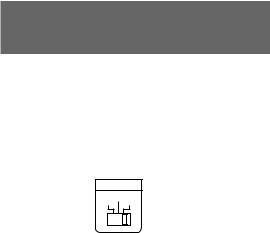
TV SYSTEM switch
(except for DV-535K Taiwan model)
Video output changes as follows according to the playback disc‘s recorded format.
NTSC = PAL, PAL = NTSC conversion is possible on Video CDs. PAL = NTSC conversion is not possible on DVDs. When the TV SYSTEM switch is set to the AUTO position, the disc’s format will be output as is. When a CD or disc is not loaded, the previous video output format will be selected.
TV SYSTEM
PAL
NTSC AUTO
|
|
|
|
|
|
|
|
|
|
|
|
|
|
|
|
|
|
Disc |
|
|
|
|
|
Output format |
|
|
|
|
|
|
|
|
|
|
|
Type |
|
Format |
|
Position of TV SYSTEM switch |
||||
|
|
|
NTSC |
PAL |
AUTO |
|||
|
|
|
|
|
|
|
|
|
DVD |
|
NTSC |
NTSC |
MOD. PAL |
NTSC |
|||
|
|
PAL |
|
|
|
|
PAL |
PAL |
|
|
|
|
|
|
|||
|
|
|
|
|
|
|
|
|
Video CD |
|
NTSC |
NTSC |
MOD. PAL |
NTSC |
|||
|
|
|
|
|
|
|
|
|
|
|
PAL |
NTSC |
PAL |
PAL |
|||
|
|
|
|
|
|
|
|
|
CD, No disc |
|
|
NTSC |
PAL |
NTSC or PAL |
|||
About MOD. (Modulation) PAL
•SHRINK
Most models of the newly developed countdown PAL TV system detect 50 Hz (PAL)/60 Hz (NTSC) and automatically switch vertical amplitude, resulting in a display without vertical shrinkage.
•If your PAL TV does not have a V-Hold control, you may not be able to view NTSC disc because the picture may roll. If the TV has a V-Hold control, adjust it until the picture stops rolling. On some TVs, the picture may shrink vertically, leaving black bands at the top and bottom of the screen. This is not a malfunction; it is caused by the NTSC = PAL conversion.
16
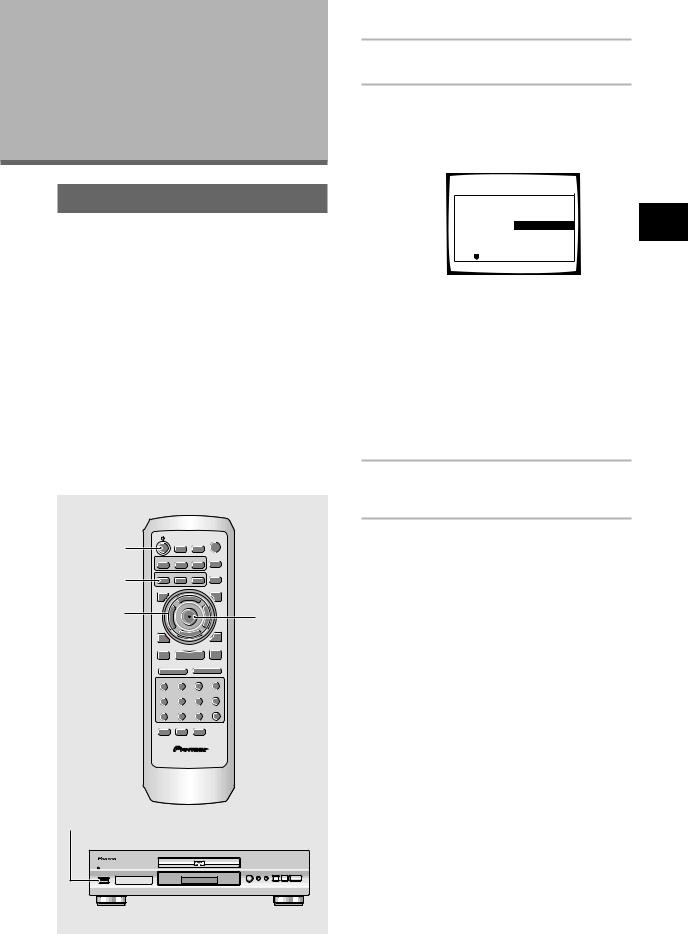
Setting Up the
Player
Using the Setup Navigator
The Setup Navigator has been designed to simplify the process of getting the DVD player ready to perform. Designed as a series of on-screen multiple-choice questions, the Setup Navigator automatically sets the audio, video, and language settings according to how the questions are answered. Once this procedure is complete, it will be possible to begin using the DVD player to enjoy DVDs.
The procedure on this page describes the operations necessary to function within the Setup Navigator screens. A detailed description of the contents of each question that appears on the screen can be found on the following pages.
When setting up for the first time
Some DVDs start playing automatically when loaded in the player. Because the Setup Navigator cannot be used if a disc is playing, it is recommended to set up the player using the Setup Navigator before loading a DVD for the first time. If a DVD has been loaded, be sure to press STOP 7 before proceeding.
|
|
|
|
OPEN/ |
|
1 |
|
LAST |
CONDITION |
CLOSE |
|
|
MEMORY |
MEMORY |
|
|
|
|
AUDIO |
SUB TITLE |
ANGLE |
REPEAT |
|
2 |
|
|
|
REPEAT |
|
SETUP |
MENU |
TOP MENU |
A-B |
|
|
DISPLAY |
|
|
RETURN |
|
|
|
¶ |
|
5 |
¶ |
|
3 |
|
|
T |
|
4 |
|
EN ER |
|
|||
5 |
|
|
5 |
||
|
PREV |
|
|
NEXT |
|
|
|
|
|
¢ |
|
|
¶ |
|
5 |
¶ |
|
|
STOP 7 |
PLAY 3 |
PAUSE 8 |
|
|
|
|
|
¶ |
|
|
|
eSTEP/SLOWE 1REV |
FWD ¡ |
|
||
|
1 |
2 |
3 |
CLEAR |
|
|
4 |
5 |
6 |
+10 |
|
|
|
¶ |
|
|
|
|
7 |
8 |
9 |
0 |
|
|
RANDOM |
PROGRAM SEARCH MODE |
|
||
|
|
|
|
Î |
|
1
STANDBY/ON |
0 41 ¡¢ 7 8 |
3 |
Î
1 Press  STANDBY/ON on the front panel (
STANDBY/ON on the front panel ( on the remote control).
on the remote control).
2 Press SETUP.
When SETUP is pressed for the first time, the following screen appears. Though the Setup Navigator may be used more than once, this screen
|
only appears |
. |
||||||||||||
|
|
|
|
|
|
|
|
|
|
|
|
|
|
|
|
|
|
|
|
|
|
|
|
|
|
|
|
|
|
|
|
Audio1 |
Audio2 |
Video |
Language |
General |
|
|
|
|||||
|
|
|
Setup Navigator |
|
|
|
|
|
|
|
||||
|
|
|
|
|
|
|||||||||
|
|
|
Setup Navigator |
Start |
|
|||||||||
|
|
|
|
Move |
|
|
Auto Start Off |
|
||||||
|
|
|
|
|
|
Select |
|
Exit |
||||||
|
|
|
|
ENTER |
SETUP |
|||||||||
|
|
|
|
|
|
|
|
|
|
|
|
|
|
|
|
|
|
|
|
|
|
|
|
|
|
|
|
|
|
3 Use the cursor buttons (5/ ) to make a selection.
•If you are going to use the Setup Navigator, it is not necessary to change the setting on the first screen. Please proceed to the next step.
•If you do not want to set up the player using the Setup Navigator, use the cursor button ( ) to select [Auto Start Off] at this time.
The Setup Navigator function may still be used at a later time in manual Setup screen menu operation (page 24).
4 Press ENTER.
The selection is entered and the next Setup Navigator screen appears.
Use steps 3 and 4 as a basis for entering selections on the all of the Setup Navigator screens described on the following pages.
To change the answer to a prior question
Use the cursor button (2) to return to previous screens. Please note, however, that you cannot go forward using the cursor button (3), so it will be necessary to answer all the questions that occur after the screen that was returned to.
To exit the Setup Navigator
Press SETUP while on any of the screens to exit the Setup Navigator. Please note that if the Setup Navigator is exited before all the questions are answered, no settings are changed.
To return to the Setup screen
Press RETURN. The Setup Navigator is exited and the Setup screen General menu screen appears. Please note that no settings are changed if RETURN is pressed before the Setup Navigator is finished.
PLAYER THE UP SETTING / CONNECTIONS MAKING
17
